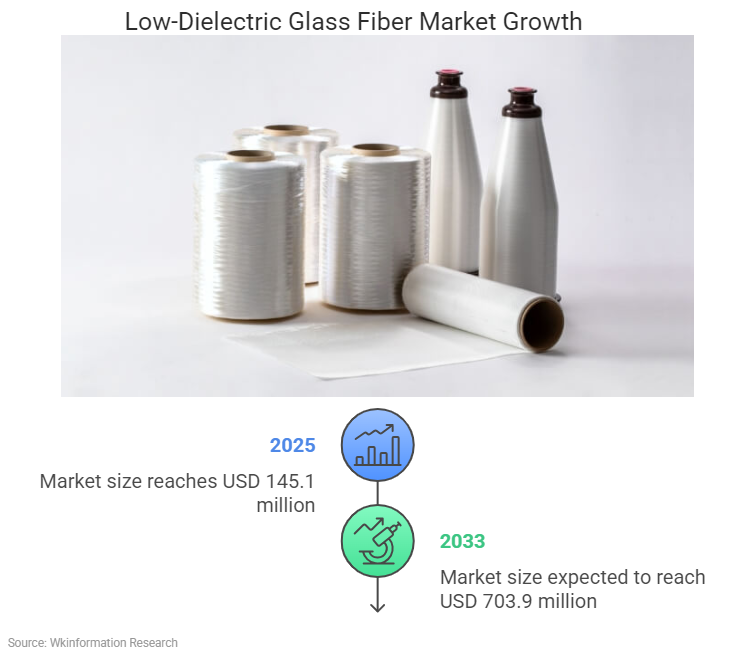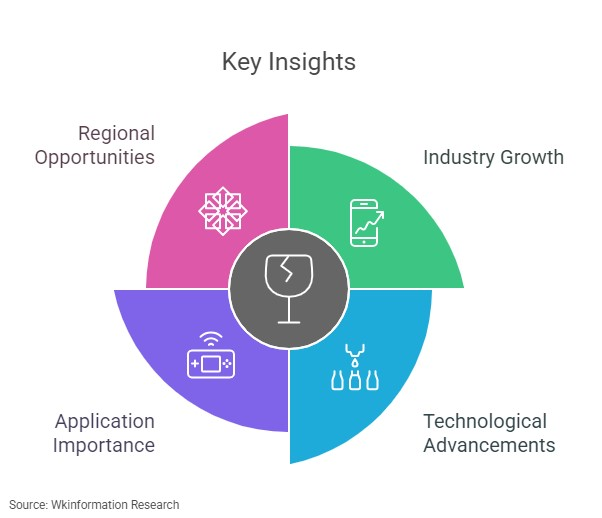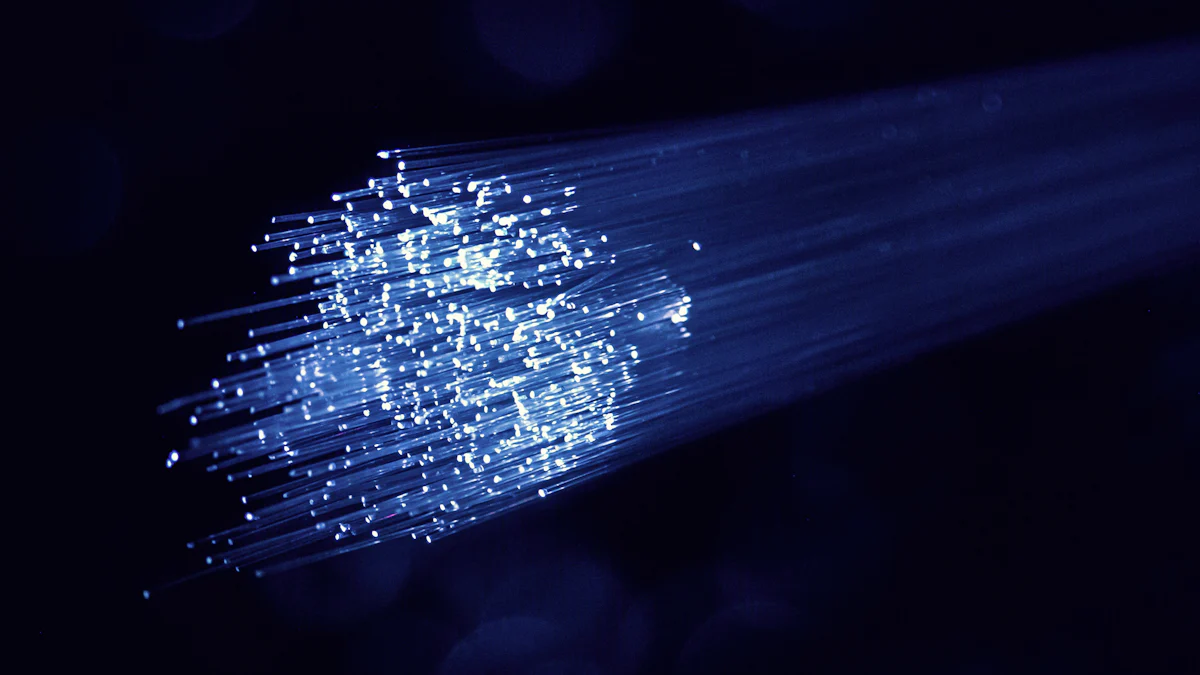
The low-dielectric glass fiber market is experiencing remarkable growth, driven by its critical role in advanced technologies. The market size will reach USD 145.1 million in 2025 and is expected to reach USD 703.9 million by 2033, with a CAGR of 21.82% from 2025 to 2033. This growth aligns with the increasing demand for high-frequency applications, particularly in telecommunications and electronics.
Technological advancements are reshaping the industry by enabling the development of innovative materials that enhance performance and reduce costs. These advancements support the creation of smaller, energy-efficient electronic components, essential for high-speed communication technologies like 5G. The focus on miniaturization and energy efficiency further underscores the importance of low-dielectric glass fibers in modern infrastructure.
Key Insights
- The low-dielectric glass fiber market is growing fast. This is because more people need it for telecom and electronics.
- New technology, like automated fiber placement, makes production quicker. It also helps companies save money.
- 5G and IoT are making low-dielectric glass fibers important. These fibers help signals stay strong and avoid problems.
- Lightweight and heat-resistant materials are key for planes and cars. They help these industries improve and save fuel.
- Countries in Asia-Pacific have big chances to grow this market. Better electronics and 5G are helping this happen.

Key Trends in the Low-Dielectric Glass Fiber Market (2025)

Increasing Demand for High-Frequency Applications
The growing reliance on high-frequency applications is driving significant demand in the low-dielectric glass fiber market. Industries such as telecommunications, aerospace, and automotive increasingly require materials that can support high-speed data transmission with minimal signal loss. Low-dielectric glass fibers excel in these applications due to their ability to reduce electromagnetic interference and maintain signal integrity.
In telecommunications, these fibers play a pivotal role in manufacturing high-frequency circuit boards and antennas. Their unique properties make them indispensable for ensuring the performance and reliability of modern communication systems. As industries continue to prioritize efficiency and performance, the demand for low-dielectric materials is expected to rise steadily.
Advancements in Manufacturing Technologies
Technological advancements are transforming the production of low-dielectric glass fibers, enhancing both efficiency and quality. Key innovations include automated fiber placement, specialized surface treatments, and continuous production methods.
| Advancement Type | Description |
|---|---|
| Automated Fiber Placement | Enhances precision and efficiency in fiber production. |
| Specialized Glass Fiber Surface Treatments | Improves the performance characteristics of the glass fibers. |
| Continuous Production Methods | Increases production speed and reduces costs, leading to more cost-effective manufacturing. |
These advancements enable manufacturers to meet the growing demand while maintaining competitive pricing. Continuous production methods, in particular, have proven instrumental in reducing costs, making low-dielectric glass fibers more accessible to a broader range of industries.
Rising Adoption in 5G and IoT Technologies
The rapid deployment of 5G networks and the expansion of IoT applications are reshaping the low-dielectric glass fiber market. Telecommunications companies rely on these fibers to build infrastructure capable of handling high-frequency data transmission with minimal interference.
- Low-dielectric glass fibers are critical for producing high-frequency circuit boards and antennas.
- These materials ensure efficient signal transmission and reduced electromagnetic interference.
- The growth of IoT applications highlights the need for materials that maintain signal integrity in connected devices.
As 5G and IoT technologies continue to evolve, the importance of low-dielectric glass fibers will only increase. Their role in enabling high-speed, energy-efficient communication systems positions them as a cornerstone of modern infrastructure.
Focus on Lightweight and High-Thermal-Resistant Materials
Lightweight and high-thermal-resistant materials are becoming essential in the low-dielectric glass fiber market. These materials offer significant advantages across industries such as aerospace, automotive, and telecommunications. Their ability to reduce weight enhances fuel efficiency in vehicles and aircraft, which is critical for meeting sustainability goals. In addition, their high thermal resistance ensures durability in extreme environments, making them ideal for advanced applications.
In the automotive sector, lightweight materials contribute to improved vehicle performance by reducing overall mass. This reduction directly impacts fuel consumption, enabling manufacturers to meet stringent environmental regulations. Similarly, in aerospace, these materials allow for the development of lighter aircraft components, which improves fuel efficiency and reduces operational costs.
High-thermal-resistant materials also play a pivotal role in electronics and telecommunications. They maintain signal integrity and minimize electromagnetic interference, which is crucial for high-speed data transmission. For instance, these materials are used in circuit boards and antennas to ensure reliable performance in high-frequency applications. Their ability to withstand high temperatures further enhances their suitability for demanding environments.
The focus on these advanced materials reflects the broader trends shaping the low-dielectric glass fiber market. As industries prioritize efficiency and sustainability, the demand for innovative solutions will continue to grow, driving further advancements in material science.
Market Dynamics in the Low-Dielectric Glass Fiber Market
Growth Drivers
Expansion of Electronics and Telecommunications Sectors
The electronics and telecommunications sectors are driving the growth of the low-dielectric glass fiber market. The increasing use of these fibers in printed circuit boards (PCBs) highlights their importance in modern technology. High-performance PCBs, essential for smartphones and telecommunications equipment, rely on low-dielectric materials to ensure efficient signal transmission.
The demand for high-speed communication technologies, such as 5G, further accelerates this trend. Industries prioritize materials that minimize signal interference and maintain integrity in high-frequency applications. As a result, the market continues to expand, supported by the emphasis on miniaturization and energy efficiency in electronic devices.
Increasing R&D Investments in Advanced Materials
Research and development investments in advanced materials are reshaping the market landscape. Manufacturers are focusing on creating innovative formulations and production processes to meet the growing demand for high-performance materials. These efforts enhance the properties of low-dielectric glass fibers, making them suitable for a broader range of applications.
R&D initiatives also address sustainability concerns by promoting eco-friendly production methods. This aligns with global trends toward reducing environmental impact, further boosting the market’s growth potential.
Challenges
High Production Costs
The production of low-dielectric glass fibers involves significant costs. Specialized processing equipment and advanced manufacturing techniques contribute to these expenses. Competitive pricing pressures in the market further strain profit margins, making it challenging for manufacturers to balance quality and affordability.
Limited Availability of Raw Materials
Raw material availability poses another challenge. Fluctuating prices and supply chain disruptions impact the production process, leading to delays and increased costs. Regulatory complexities surrounding the use of certain chemicals in glass fiber production add to these difficulties, hindering market entry for new players.
Opportunities
Emerging Markets in Asia-Pacific
The Asia-Pacific region presents significant growth opportunities for the low-dielectric glass fiber market. Countries like China, Japan, and South Korea are leading the way in electronics manufacturing and automotive production. The adoption of 5G technology in this region drives demand for materials capable of high-frequency data transmission.
Lightweight materials are also gaining traction in the automotive and aerospace sectors, where fuel efficiency is a priority.
Innovations in Composite Materials
Innovations in composite materials are creating new possibilities for the market. Manufacturers are developing advanced low-dielectric glass fibers to meet the needs of high-frequency applications. These innovations improve material properties, making them more efficient and durable.
The trend toward eco-friendly production processes aligns with sustainability goals, further enhancing the appeal of these materials. As industries continue to adopt advanced communication technologies like 5G and IoT, the demand for innovative composite materials will grow.
Key Players and Market Share in the Low-Dielectric Glass Fiber Market
Overview of Leading Companies
- Saint-Gobain Vetrotex
- Nittobo
- AGY
- Taishan Fiberglass
- Taiwan Glass
- Fulltech Fiber Glass
- …… (More Player will show in our freesample)market dominance.
Competitive Landscape Analysis
The competitive landscape of the low-dielectric glass fiber market is shaped by the efforts of leading companies to differentiate themselves. These players focus on enhancing product performance, reducing production costs, and meeting the evolving needs of industries such as telecommunications and aerospace.
The market’s competitive nature drives companies to adopt strategies that ensure long-term growth and profitability. These strategies include leveraging advanced technologies, forming strategic partnerships, and expanding their global footprint.
Strategies Adopted by Key Players
Leading companies in the low-dielectric glass fiber market employ various strategies to maintain their competitive edge. Continuous investment in research and development enables them to create innovative products tailored to high-frequency applications. Strategic partnerships and collaborations allow these players to expand their market reach and strengthen their supply chains.
Mergers and acquisitions also play a crucial role in consolidating market positions. For example, companies focus on acquiring smaller firms with specialized expertise to enhance their value proposition. Differentiation strategies, such as offering eco-friendly and high-performance materials, further help companies address the growing demand for sustainable solutions.
Technological Advancements in the Low-Dielectric Glass Fiber Market

Innovations in Glass Fiber Production
Recent innovations in glass fiber production are transforming the low-dielectric glass fiber market. Advanced manufacturing methods, such as automated fiber placement and 3D printing, have significantly improved efficiency while reducing production costs. These technologies enable the creation of complex designs with minimal material waste, aligning with the industry’s growing emphasis on sustainability.
Emerging trends in ultra-high modulus glass fibers are also driving market growth. These fibers offer superior strength and stiffness, making them ideal for demanding applications in construction and automotive industries. Additionally, the use of recycled materials and bio-based resins is gaining traction among eco-conscious consumers. This shift not only supports environmental goals but also opens new investment opportunities for manufacturers.
Integration with Advanced Composite Technologies
The integration of advanced composite technologies has enhanced the performance of low-dielectric glass fibers. These technologies allow manufacturers to develop innovative formulations that meet the specific demands of high-frequency applications. For instance, advanced composites improve the quality and cost-effectiveness of glass fiber products, making them more accessible to industries like telecommunications and aerospace.
A growing focus on materials that support advanced communication technologies, such as 5G and IoT, has further influenced the market. These materials ensure efficient signal transmission and minimal interference, which are critical for modern communication systems. By leveraging advanced composites, manufacturers can address the evolving needs of these industries while maintaining a competitive edge.
Role of Automation in Enhancing Efficiency
Automation plays a pivotal role in optimizing the production of low-dielectric glass fibers. Streamlined production lines enhance scalability and flexibility, enabling manufacturers to meet increasing demand without compromising quality. Artificial intelligence (AI) further supports this process by facilitating predictive maintenance and quality control. These capabilities reduce waste and improve product consistency, ensuring that manufacturers deliver high-quality materials to their clients.
Automation also helps lower operational costs by minimizing manual intervention and maximizing resource utilization. This efficiency not only benefits manufacturers but also contributes to the overall growth of the low-dielectric glass fiber market. As automation technologies continue to evolve, their impact on production processes will likely expand, driving further advancements in the industry.
Regional Analysis of the Low-Dielectric Glass Fiber Market
North America
North America remains a key region in the low-dielectric glass fiber market, driven by its robust electronics and telecommunications sectors. The demand for high-performance materials, particularly in advanced communication infrastructure, continues to grow. Low-dielectric glass fibers are essential for manufacturing high-performance printed circuit boards (PCBs), which are widely used in telecommunications equipment and consumer electronics.
Regulatory support in the region fosters technological advancements, encouraging manufacturers to innovate and meet the rising demand. The increasing adoption of 5G networks further accelerates the need for these materials, as they ensure efficient signal transmission and minimal interference. North America’s established industrial base and focus on cutting-edge technologies position it as a leader in the global market.
Europe
Europe’s low-dielectric glass fiber market is expanding rapidly, supported by technological innovation and sustainability initiatives. Several factors contribute to this growth:
- Countries like Germany, the UK, and France lead the adoption of advanced materials in electronics and telecommunications.
- EU initiatives promoting 5G networks and IoT applications drive demand for low-dielectric glass fiber solutions.
- The automotive and aerospace sectors increasingly rely on these materials for lightweight and high-performance components.
Asia-Pacific
Asia-Pacific represents a significant growth opportunity for the low-dielectric glass fiber market. Countries such as China, Japan, and South Korea dominate electronics manufacturing and automotive production, creating a strong demand for advanced materials. The rapid deployment of 5G networks in the region further boosts the adoption of low-dielectric glass fibers.
Lightweight materials are gaining traction in the automotive and aerospace industries, where fuel efficiency and performance are critical. Asia-Pacific’s focus on technological advancements and cost-effective manufacturing processes positions it as a hub for innovation. The region’s market is expected to grow steadily, driven by its expanding industrial base and increasing investments in advanced communication technologies.
Note: Asia-Pacific’s role in the global market highlights its potential as a leader in innovation and development, particularly in high-frequency applications.
Rest of the World
The low-dielectric glass fiber market in regions outside North America, Europe, and Asia-Pacific is gaining momentum. Emerging economies in South America, the Middle East, and Africa are witnessing increased adoption of advanced materials, driven by the growing aerospace and telecommunications sectors. These regions are leveraging low-dielectric glass fibers to meet the rising demand for lightweight and high-performance solutions.
The aerospace industry plays a pivotal role in driving market growth across these regions. Manufacturers are integrating low-dielectric glass fibers into critical components such as radomes and antenna windows. These materials enhance fuel efficiency by reducing the overall weight of aircraft. Their ability to minimize electromagnetic interference ensures better communication and navigation signals, which are essential for modern aviation systems.
Several factors contribute to the expanding market in these regions:
- Aerospace advancements: The focus on lightweight materials aligns with the industry’s need for fuel-efficient aircraft.
- Telecommunications growth: The increasing deployment of communication networks drives the demand for high-frequency materials.
- Infrastructure development: Investments in modernizing infrastructure create opportunities for advanced materials in construction and electronics.
The Middle East, in particular, is emerging as a key player due to its investments in aerospace and defense technologies. South America is also experiencing growth, supported by its expanding telecommunications sector. Africa, while still in the early stages, shows potential as infrastructure projects gain traction.
Tip: Companies targeting these regions should prioritize partnerships with local industries to capitalize on the growing demand for advanced materials. Tailoring solutions to meet regional needs can provide a competitive advantage in these untapped markets.
The “Rest of the World” segment highlights the global reach of the low-dielectric glass fiber market. As industries in these regions continue to evolve, the demand for innovative materials will likely accelerate, creating new opportunities for manufacturers.
Future Outlook for the Low-Dielectric Glass Fiber Market (2025-2033)
Projected Market Growth and CAGR
The low-dielectric glass fiber market is poised for substantial growth between 2025 and 2033. Analysts project a steady compound annual growth rate (CAGR), driven by the increasing adoption of advanced communication technologies such as 5G and IoT. Industries like telecommunications, aerospace, and automotive will continue to demand materials that enhance performance while reducing signal interference.
The market’s expansion aligns with global trends emphasizing energy efficiency and sustainability. Manufacturers are expected to invest heavily in research and development to meet these demands. This focus on innovation will likely result in new product offerings that cater to high-frequency applications, further boosting market growth.
Emerging Applications in Aerospace and Defense
Aerospace and defense sectors are emerging as significant contributors to the low-dielectric glass fiber market. These industries require materials that combine lightweight properties with high strength to endure extreme conditions. Low-dielectric glass fibers meet these needs while minimizing signal interference, making them indispensable for communication and navigation systems.
Advancements in aerospace technology increasingly prioritize stealth and operational efficiency. Low-dielectric glass fibers play a critical role in achieving these objectives. In the defense sector, the demand for materials capable of withstanding harsh environments fosters innovation and drives adoption. This trend underscores the growing importance of these fibers in high-performance applications.
Potential Impact of Regulatory Changes
Regulatory changes will likely shape the future of the low-dielectric glass fiber market. Stricter standards on material quality, safety, and environmental impact will push manufacturers toward sustainable practices. While these regulations may increase production costs, they also create opportunities for companies to differentiate themselves through eco-friendly solutions.
Trade regulations and import-export dynamics will also influence the market. Regional differences in regulatory frameworks could impact pricing and availability, presenting both challenges and opportunities for manufacturers. Companies that adapt to these changes effectively will gain a competitive edge in the evolving market landscape.
Overview
The low-dielectric glass fiber market is poised for transformative growth, driven by advancements in manufacturing technologies and the rising demand for high-frequency applications. Industries such as telecommunications, aerospace, and automotive continue to adopt these materials for their superior performance and energy efficiency. Emerging markets in Asia-Pacific and innovations in composite materials further amplify the market’s potential.
Leading manufacturers are driving innovation through strategic collaborations and investments in emerging technologies. By aligning with these trends, stakeholders can secure a competitive edge in this evolving market.
| Report Metric | Details |
|---|---|
| Report Name | Global Low-Dielectric Glass Fiber Market Report |
| Base Year | 2024 |
| Segment by Type |
· Staple Fiber · Glass Fiber Cloth · Glass Fiber Yarn |
| Segment by Application |
· High Performance PCB · Electromagnetic Windows · Others |
| Geographies Covered |
· North America (United States, Canada) · Europe (Germany, France, UK, Italy, Russia) · Asia-Pacific (China, Japan, South Korea, Taiwan) · Southeast Asia (India) · Latin America (Mexico, Brazil) |
| Forecast units | USD million in value |
| Report coverage | Revenue and volume forecast, company share, competitive landscape, growth factors and trends |
FAQ
1. What are low-dielectric glass fibers, and why are they important?
Low-dielectric glass fibers are specialized materials with minimal electrical signal interference. They are essential for high-frequency applications, such as 5G networks and IoT devices, due to their ability to maintain signal integrity and reduce electromagnetic interference.
2. Which industries benefit the most from low-dielectric glass fibers?
Telecommunications, aerospace, automotive, and electronics industries benefit significantly. These fibers enhance performance in high-frequency applications, lightweight components, and thermal-resistant materials, making them indispensable for modern technologies.
3. What challenges do manufacturers face in this market?
Manufacturers encounter high production costs and raw material shortages. These challenges stem from advanced manufacturing requirements and supply chain disruptions, which impact pricing and availability.
4. How does Asia-Pacific contribute to the market’s growth?
Asia-Pacific leads in electronics manufacturing and 5G deployment. Countries like China and South Korea drive demand for low-dielectric glass fibers, supported by their focus on cost-effective production and technological advancements.
5. What role does sustainability play in this market?
Sustainability drives innovation in eco-friendly production methods and materials. Manufacturers increasingly adopt recycled and bio-based components to align with environmental regulations and consumer preferences, enhancing market appeal.
Global Low-Dielectric Glass Fiber Market Report (Can Read by Free sample) – Table of Contents
Chapter 1: Low-Dielectric Glass Fiber Market Analysis Overview
- Competitive Forces Analysis (Porter’s Five Forces)
- Strategic Growth Assessment (Ansoff Matrix)
- Industry Value Chain Insights
- Regional Trends and Key Market Drivers
- Low-Dielectric Glass Fiber Market Segmentation Overview
Chapter 2: Competitive Landscape
- Global Low-Dielectric Glass Fiberplayers and Regional Insights
- Key Players and Market Share Analysis
- Sales Trends of Leading Companies
- Year-on-Year Performance Insights
- Competitive Strategies and Market Positioning
- Key Differentiators and Strategic Moves
Chapter 3: Low-Dielectric Glass Fiber Market Segmentation Analysis
- Key Data and Visual Insights
- Trends, Growth Rates, and Drivers
- Segment Dynamics and Insights
- Detailed Market Analysis by Segment
Chapter 4: Regional Market Performance
- Consumer Trends by Region
- Historical Data and Growth Forecasts
- Regional Growth Factors
- Economic, Demographic, and Technological Impacts
- Challenges and Opportunities in Key Regions
- Regional Trends and Market Shifts
- Key Cities and High-Demand Areas
Chapter 5: Low-Dielectric Glass Fiber Emerging and Untapped Markets
- Growth Potential in Secondary Regions
- Trends, Challenges, and Opportunities
Chapter 6: Product and Application Segmentation
- Product Types and Innovation Trends
- Application-Based Market Insights
Chapter 7: Low-Dielectric Glass Fiber Consumer Insights
- Demographics and Buying Behaviors
- TargetAudience Profiles
Chapter 8: Key Findings and Recommendations
- Summary of Low-Dielectric Glass Fiber Market Insights
- Actionable Recommendations for Stakeholders



